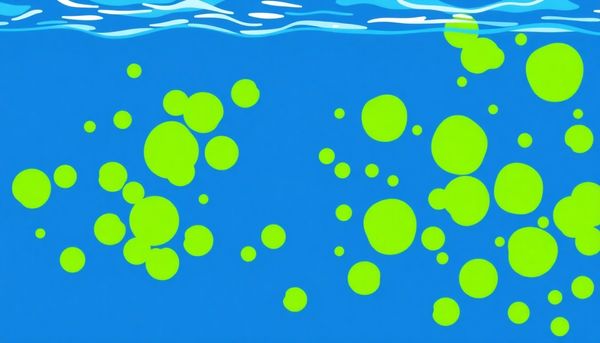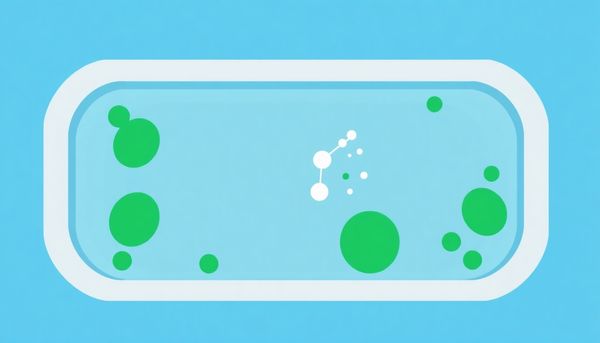Master Pool Stain Removal: Identify, Treat, and Prevent Blemishes
December 14th, 2024
December 14th, 2024
A pristine pool shimmering under the sun is every pool owner's dream. Yet, as those azure waters invite relaxation, they can also quietly harbor unsightly blemishes. Pool stains, those persistent blots, often sneak in unnoticed, leaving owners baffled and frustrated. My own experience with a particularly stubborn rust-colored stain taught me that these spots aren't just about aesthetics—they're clues to what's happening beneath the surface.
Each stain tells a story, a narrative of chemical imbalance, environmental factors, or even misguided maintenance. For instance, organic stains, such as those from leaves or algae, often take on a green or brown hue, while metallic stains from iron or copper can appear as rusty or bluish marks. Knowing how to differentiate between these can save you time, effort, and money.
Over the years, I've learned the hard way that successful stain removal starts with accurate identification. This knowledge allows you to choose the right approach, whether it's a simple scrubbing with specialized cleaners or employing more complex chemical treatments. The joy of seeing a refreshed, spotless pool is worth the effort, and understanding the nature of pool stains is the first step in achieving that.
In this guide, we'll explore effective methods to diagnose and eliminate these watery nuisances, ensuring your pool remains a source of pride and enjoyment.

Standing at the edge of your pool, the sight of unsightly stains can be perplexing. To tackle them effectively, it’s crucial to first play detective and identify the origins of these blemishes. Stains in pools typically fall into a couple of broad categories: organic and metallic. The secret to discerning their type often lies in their hue.
Organic stains are the usual suspects, typically manifesting as greenish-brown discolorations. Leaves, algae, or even berries from nearby vegetation might be the culprits. I remember a neighbor lamenting the mysterious stains on his pool steps, only to realize the grapevine overhead was the source. A simple chlorine test can confirm this: a dab of chlorine will usually erase an organic stain.
However, if your stains lean toward the reddish-brown spectrum, metals like iron might be at work. Often, well water is to blame, rich in minerals that can discolor surfaces. This occurred at a friend’s countryside retreat, where their pool suddenly bore rust-colored spots after a rainy week. Applying ascorbic acid can help determine if metals are the cause — the stain should lighten or vanish if metals are involved.
By understanding the nuances of pool stains, you not only solve the mystery but set the stage for effective removal and prevention. Once you’ve pinpointed the stain type, you’re well on your way to restoring your pool’s pristine condition.
When you're dealing with a stained pool, the first step in tackling the issue is understanding the stain's origin. Imagine a detective piecing together clues—this is your role in unraveling the mystery of pool stains. Stains in pools often emerge from two primary sources: organic materials and metals. Each has its own distinct markers.
Organic stains typically present themselves in hues of greenish-brown. These unwelcome guests are often the result of leaves, twigs, or even flowers that have drifted into the water. If you spot a purplish tinge, it may be berries—the vibrant culprits from overhanging branches. My neighbor once discovered his pool resembling a botanical art exhibit after a particularly windy night, all due to nearby berry bushes.
Metal stains, on the other hand, tell a different story. They can appear as rusty reds or inky purples, suggesting the presence of iron or manganese. Copper stains are less vivid but equally pesky, often manifesting as dull, stubborn marks. Copper can sneak into your pool via corroded pipes or the use of certain algaecides. A friend of mine battled mysterious blue-green patches for weeks, only to trace them back to an old copper pipe system.
Once you’ve gathered these clues, testing your theory becomes crucial. Organic stains will fade away with a bit of chlorine, while metal stains respond to ascorbic acid treatments. Solving this puzzle not only restores your pool's allure but also arms you against future stain invasions.
When faced with mysterious stains in your pool, a bit of detective work is essential. Identifying the culprits behind these blemishes can seem daunting, but a systematic approach helps unravel the mystery. Begin by examining the stain’s color and texture, as these characteristics provide clues about its origin. Stains with hues of greenish-brown often suggest organic materials like leaves or berries. If your pool is shaded by trees, you might find that the vibrant berries are the offenders.
Different colors, however, might indicate metal traces. Copper, for example, tends to leave blue or green shadows, while iron favors reddish-brown smudges. A friend once had a pool that mirrored a Jackson Pollock painting due to a rusty old fence nearby. It took a rainy season for the rust to seep into her pool water and create an unexpected art installation.
To confirm your hypothesis, a simple test can save time and frustration. A chlorine test can dissolve organic stains, disappearing like a magician’s trick. Meanwhile, metal stains remain stubbornly unchanged. In such cases, sprinkle a pinch of ascorbic acid—often found in vitamin C tablets—directly on the stain. If it lightens, metal is your foe.
Once you’ve cracked the code, you can embark on the next phase: choosing the right treatment. This initial sleuthing saves you from unnecessary trial and error, leading to a pristine pool that beckons for a refreshing dip.
Stains, like unexpected guests at a party, have a way of showing up in your pool despite your best efforts to keep them at bay. Engaging in effective stain-removal techniques is essential to reclaim that pristine aquatic sanctuary. Here's how you can tackle those unwelcome blemishes with confidence.
Understanding the nature of the stain is your first step toward effective removal. Organic stains, often left by leaves or berries, respond well to a good dose of chlorine. By over-chlorinating the pool, also known as shocking, you break down the organic matter causing the discoloration. It’s crucial to perform this process at dusk or nighttime to maximize the shock’s potency.
Conversely, if your pool is plagued by metal stains, ascorbic acid will be your ally. This vitamin C powder works wonders on stains caused by metals like iron and copper. Simply sprinkle it directly on the stain and watch as it fades away. However, don’t be fooled—while a sequestrant can prevent metals from causing future stains by binding them, it won’t remove existing ones.
Consistency is key. Regularly testing your pool water can help prevent future stains, and maintaining a balanced pH level will keep both organic and inorganic contaminants in check. Armed with the right tools and techniques, those pool stains, whether organic or metallic, will soon become a thing of the past, ensuring your swimming space remains inviting and spotless.

Staring at your pool, you might wonder how those unsightly stains appeared despite your diligent efforts. The answer often lies in understanding the culprit behind the discoloration. Different stains require different treatments, and applying the right remover is crucial for a clean pool.
First, pinpointing the stain's origin is essential. Organic stains, often left by fallen leaves or berries, respond well to a chlorine treatment. A simple trick is to rub a small amount of chlorine directly on the stain. If it fades, you’ve likely identified the offender as organic.
On the other hand, metal stains, notorious for their stubbornness, require a different approach. These can be the result of copper, iron, or manganese deposits in your water. To tackle these, ascorbic acid—commonly known as vitamin C—proves effective. Sprinkle some on the stain, and if it begins to disappear, you’ve confirmed a metal stain.
Once identified, the next step is treatment. Organic stains can be managed with a pool shock, a potent form of chlorine designed to sanitize and clear stains. For metal stains, a quality metal stain remover or sequestrant will help lift the discoloration. Regular use of a sequestrant can also prevent metals from depositing.
Personal experience has shown that tackling pool stains swiftly prevents them from becoming more embedded and challenging to remove. Armed with the right knowledge and products, you can keep your pool inviting and pristine, ready for those sunny afternoons.
Strolling around the pool deck, you might notice an unexpected blotch marring the pristine blue of your oasis. Identifying the type of stain is crucial before embarking on the mission to remove it. Pool stains typically fall into two main categories: organic and metal-based. Recognizing these can save time and effort.
Organic stains often present themselves in shades of greenish-brown, mainly resulting from natural debris like leaves, twigs, or berries that have lingered too long. If your pool is nestled beneath a canopy of berry-producing trees, it's no surprise when their vibrant colors transfer onto the pool surface. Organic stains are generally the easiest to identify and treat; a simple application of chlorine can typically lift them away.
On the other hand, metal stains can be more perplexing and diverse in appearance. Reddish-brown spots might indicate iron, a common element in well water or from rusting metal objects nearby. Manganese, with its telltale dark purple hues, also appears in well water and requires more specialized treatment. Copper stains, showing up as teal or turquoise patches, could stem from corroded copper pipes or excessive use of copper-based algaecides.
To confirm your suspicions, a practical test can be performed: apply vitamin C powder to the suspected area. If the stain lightens, you’re likely dealing with a metal stain. Once correctly identified, you can confidently choose the appropriate treatment, ensuring your pool returns to its original, inviting appearance.
While basking in the glow of a perfectly clear pool, the sudden appearance of a stain can feel like an unwelcome guest. To restore your slice of paradise, pinpointing the stain's source is crucial. Start by considering your pool's surroundings. Are there trees or plants nearby? Leaves and berries often leave behind greenish or brownish marks, their vibrant pigments settling on surfaces after they fall.
Shifting focus, inspect your water source. Well water can introduce metals like copper, iron, and manganese, each leaving its own signature stain. Copper tends to create blue-green discolorations, while iron manifests as rust-colored spots. Manganese, though less common, can leave an unmistakable dark purple trace. If your water comes from a well, or if your plumbing system includes copper pipes, these elements might be your culprits.
Once you've speculated the source, a simple experiment can confirm your suspicions. For organic stains, a small dose of chlorine applied directly can work wonders, as it should fade or vanish if plant matter is responsible. On the other hand, metal stains remain stubborn against chlorine. Applying ascorbic acid, a common household item found in vitamin C tablets, can lighten or erase these blemishes if metals are involved.
Understanding these potential sources not only helps in choosing the right remedy but also empowers you to take preventive measures, ensuring your pool stays as inviting as a summer day.
Addressing pool stains demands both strategy and skill. The first step is accurate identification, as this ensures the right tool is used for the job. Organic stains, often greenish-brown, usually result from leaves or berries. A sprinkle of chlorine can test their nature, as it will typically dissolve organic matter. Metals, however, require a more specialized approach. A little ascorbic acid, akin to crushed vitamin C, can reveal metal stains by lightening or removing them.
In my backyard, I once noticed a stubborn purplish blotch on the pool floor. It turned out to be manganese from our well water. After confirming it with a simple acid test, I applied a metal stain remover specifically designed for pools. Voila, the stain was gone, and a metal sequestrant was added to prevent a repeat performance.
To maintain crystal-clear waters, shocking the pool at night is essential. This ensures the chlorine can work uninterrupted by sunlight. Regular maintenance, including using a sequestrant, can prevent metal build-up from spiraling into noticeable stains. However, if your pool has already been marked, remember that each stain tells a story. By understanding its origins and applying targeted treatments, your pool can return to its pristine state, ready for the next swim.

Staying ahead of pool stains is akin to anticipating a plot twist in your favorite novel—once you understand the characters, you can predict where the story might go. In the aquatic world of pools, stains are those unexpected characters, and recognizing their behavior is key to prevention.
Regular maintenance serves as the first line of defense. Skimming leaves and debris daily prevents organic stains, while a weekly vacuum ensures particles don’t settle into hard-to-remove blemishes. Investing in a quality pool cover is another wise step, especially for those surrounded by trees that shed leaves and berries.
Water chemistry also plays a pivotal role. Balancing pH, alkalinity, and calcium levels not only keeps the water clear but also reduces the likelihood of mineral stains caused by metals like iron and copper. Regular water testing is essential; consider using a metal sequestrant to bind metals, rendering them harmless before they can cause trouble.
Plumbing checks can prevent metal intrusion. Inspect your pool’s pipes and fittings for corrosion, which can introduce metals into the water. Even well water used to fill the pool should be scrutinized for its mineral content.
Ultimately, adopting a proactive approach means fewer surprises down the line. By understanding the origins of stains and updating your pool care routines accordingly, you’ll enjoy a pristine pool scene, free from unsightly marks.
Years ago, my neighbor shared a tale about his pool that stuck with me. Despite his meticulous cleaning routine, mysterious stains began appearing. It turned out to be an unexpected lesson in stain identification. Understanding the origin of pool stains can indeed be as crucial as the cure.
First, consider the color and location of the stain. Organic stains often appear greenish-brown, typically caused by decomposing leaves or nearby foliage. If your pool is surrounded by trees, this might be your culprit. Contrastingly, bright or dark stains could hint at berries, especially if such plants are within splashing distance.
Metal stains, however, introduce a different spectrum of hues. Reddish-brown marks suggest the presence of iron, often found when using well water or from rusting metal fixtures around your pool. Purple or dark stains may point to manganese, a metal sometimes present in both well and municipal water.
The presence of copper, identified by blue or greenish stains, can be another suspect. It's not uncommon for pools with copper piping or those using copper-based algaecides to exhibit these marks.
Once the likely source is identified, test your theory. Organic stains often vanish under the influence of chlorine, while metal stains typically respond to ascorbic acid, a common household item. Identifying these stain sources not only aids in effective removal but also forms a foundation for preventing future blemishes in your backyard oasis.
Effective stain removal from your pool requires a well-informed approach. The initial step involves identifying the stain's origin. For instance, organic stains, often appearing as greenish or brown, stem from plant debris like leaves or berries. In such cases, a robust dose of pool shock can work wonders. This method releases a concentrated burst of chlorine to break down organic material, effectively erasing unsightly blemishes.
On the other hand, mineral-based stains present a different challenge. Commonly, these stains emerge from metals like iron, copper, or manganese. Remember the time when a mysteriously persistent purple hue marred my pool? A little investigation revealed manganese was the villain, likely sneaking in from the municipal water supply. Here, ascorbic acid becomes your ally. By applying it directly to the stain, you can discern metal involvement when the stain lightens or vanishes. Once confirmed, a metal stain remover specifically designed for pool use is your best bet. This product will not only tackle existing stains but also help prevent future ones by neutralizing metal ions in the water.
Post-removal, it’s crucial to maintain vigilance to prevent reoccurrence. Regular testing of your pool water, especially if you use well water, helps in monitoring mineral levels. A metal sequestrant can also be beneficial, acting as a preventive measure by binding metals, making them easier to filter out. Pool care isn’t just about aesthetics; it’s about ensuring a clean, safe swim for everyone.
Keeping a pool pristine involves more than just reacting to stains—it's about embracing preventive maintenance. Regular upkeep not only spares you the headache of tough stains but also extends the life of your pool. My friend Olivia learned this the hard way after discovering her newly installed pool had developed unsightly spots just weeks after its debut. Frustrated, she realized her maintenance routine needed an upgrade.
Firstly, maintaining balanced water chemistry is crucial. Test your pool’s pH, alkalinity, and calcium hardness weekly. Imbalances can lead to mineral build-up or algae growth, both common causes of staining. Olivia found that a simple test kit from a local store made a world of difference, preventing issues before they started.
Secondly, keep your pool area clean. Organic debris like leaves, flowers, and seeds can lead to stains if left unchecked. Skimming the pool daily and trimming nearby foliage can drastically cut down the risk. Olivia, with a few strategic plant trimmings, kept nature at bay, safeguarding her pool’s aesthetic.
Regularly brush and vacuum your pool to prevent sediment from settling. This not only maintains cleanliness but also disrupts potential stain formation. Lastly, consider using a metal sequestrant monthly. While not a stain remover, it binds dissolved metals, making them easier to filter out before they can cause discoloration.
By implementing these habits, Olivia transformed her pool into a shimmering oasis. With a little foresight and effort, you too can enjoy a stain-free swimming season.

Stains in your pool can be tricky, but unraveling their mystery is a bit like solving a detective story. You need to play the role of a sleuth, keenly observing and testing to confirm the culprit. A thorough approach involves testing suspected stains to pinpoint their origins. Start by examining the stain’s hue: organic stains often present shades of greenish-brown, stemming from plant debris or berries. If you suspect this, try applying a small bit of chlorine directly to the stain. Its disappearance indicates that it’s indeed organic.
For more stubborn suspects like metal stains, a different tactic is required. Metals such as iron or copper may masquerade as organic matter at first glance, but applying ascorbic acid can unmask them. Sprinkle some vitamin C powder on the stain; if the spot lightens or vanishes, you've identified a metal stain. Each substance requires its own type of intervention, so accurate identification is key.
Remember the time when my friend swore his pool stains were from leaves, but a little vitamin C revealed a persistent metal problem from his aging copper pipes? His relief was palpable when he finally knew what he was dealing with. It's a small but important victory in maintaining a pristine pool. By confirming your findings through these tests, you'll be better prepared to choose the right cleaning method, ensuring your oasis remains inviting and stain-free.
Identifying the origins of pool stains is akin to solving a mystery, where each splash of color tells a story. Recognizing these clues can save time and effort in restoring your pool’s pristine appearance. Pool stains typically fall into two main categories: organic and metal-based.
Organic stains, often greenish-brown, are usually the result of natural debris such as leaves, twigs, or blooms drifting into the water. I once discovered a particularly stubborn stain after a storm, only to realize that my neighbor's beautifully lush mulberry tree had contributed more than just shade. Berries, with their vibrant hues, are notorious for leaving vivid marks, especially if the pool sits under fruit-bearing trees.
Metal stains, on the other hand, present a different challenge. Copper stains can manifest as light green or turquoise marks, often linked to corroded pool fixtures, copper algaecides, or well water with high mineral content. I recall a friend’s pool that sparkled with an unexpected teal glow, later traced back to a decorative copper fountain. Iron deposits leave reddish-brown stains, sometimes introduced via rusty poolside furniture or iron-rich well water. Meanwhile, manganese results in darker, purplish blemishes, a surprising discovery even in municipally treated water.
Once you’ve unraveled the mystery of your pool stain’s origin, precisely targeted treatment becomes straightforward. Organic stains typically succumb to chlorine treatments, while metal stains require specialized strategies. Understanding these sources isn't just about cleaning; it's about keeping your aquatic oasis clear and inviting.
Staring at the unsightly blotches in your pool, you might feel a mix of frustration and determination. It’s time to put on your detective hat and apply effective test methods to unveil the culprit behind these stains. First, consider the clues left behind by color. Organic stains, often greenish or brown, point to leaves or plant matter. Metal-based stains reveal themselves in hues of rust or deep purples, indicative of iron, copper, or manganese in the water.
Testing your assumptions can be straightforward. For suspected organic stains, try the chlorine test: apply a small quantity directly to the stain. Organic matter will typically succumb to chlorine’s bleaching power, vanishing or significantly lightening. However, if the stain stubbornly persists, it’s time to consider metal involvement. In this scenario, ascorbic acid, commonly known as vitamin C, is your best ally. Sprinkle some of this powder on the stain. If it’s caused by metals, the acid will lighten or remove it, confirming your hunch.
These simple tests save time and effort, allowing you to tackle the root cause of the staining efficiently. Remember, identifying the source is crucial, but prevention is equally important. Once you’ve dealt with the stains, implementing a regular maintenance routine will keep your pool pristine, allowing you to enjoy those sunny days without a hint of worry.
Stains may be troublesome, but preventing them is like weaving a protective cloak over your pristine pool. Understanding the origins of those unsightly marks is the initial step toward a stain-free future. Consider the environment around your pool. Overhanging trees can be picturesque, but they might also rain down organic debris such as leaves, berries, or even pollen. Regularly trimming branches and keeping the pool covered when not in use can fend off these organic invaders.
On the other hand, if your pool’s water source is a well, it could be rich with metals like iron, copper, or manganese. A quality metal sequestrant can be your best friend here, binding these metals and preventing them from settling and staining. Remember, a sequestrant isn't a stain remover but a proactive measure. It's worth incorporating into your regular maintenance regime, especially if you've battled metal stains before.
To further bolster your defense, schedule a routine brushing and vacuuming session. This helps in dislodging any particles that might have settled onto surfaces but haven't yet had the chance to taint them. Testing the water regularly ensures chemical balances are maintained, reducing the risk of stains. It's like keeping your pool in harmony with nature, rather than at odds with it. With these measures in place, your pool can remain a sparkling oasis, free from unwanted blemishes.

Strolling around your backyard oasis, a shimmering blue pool usually greets you. However, when the once-crystal waters become marred by unsightly organic stains, it’s time to tackle the issue head-on. Organic stains often manifest as greenish-brown smudges, the result of leaves, plant debris, or even fallen berries. If you spot such discolorations, don’t worry—chlorine is your trusted ally.
Chlorine’s effectiveness against organic stains is nothing short of impressive. Instead of a gentle clean, it requires a robust approach—super-chlorination. This means raising chlorine levels significantly higher than regular maintenance to break down stubborn organic matter. Pool shock, a concentrated form of chlorine, comes into play here. Not only does it annihilate bacteria, but it also eradicates the stains clinging to your pool’s surfaces.
Timing is crucial when using chlorine for stain removal. Evening hours or nighttime are ideal for shocking your pool. The absence of sunlight prevents the chlorine from dissipating too quickly, ensuring maximum effectiveness. Once you’ve added the shock, circulate the water thoroughly and give it time to work its magic overnight. By morning, your pool should look refreshed, free from those pesky organic blemishes.
Remember, maintaining regular chlorine levels can prevent these stains from reappearing. A weekly routine of testing and adjusting chlorine not only ensures sparkling waters but also guards against future intrusions by organic matter. With strategic use of chlorine, your pool remains a pristine retreat, ready for endless enjoyment.
The sparkling surface of a pool can quickly lose its allure when unsightly stains appear. Understanding the origins of these blemishes is the first step in restoring your pool's pristine condition. Organic stains are among the most common culprits, often arising from natural debris that finds its way into the water. Leaves, twigs, and even pollen are sneaky sources of discoloration, especially after a windy day or a storm. They might seem harmless floating on the surface, but once they settle, they can leave behind a stubborn greenish-brown mark.
Moreover, if your pool is surrounded by vegetation, you might find more vibrant stains popping up. Berry-bearing trees, with their tempting but troublesome fruits, can leave colorful impressions if they fall into your pool. These stains not only affect the pool's appearance but can also complicate maintenance if left unaddressed.
Another source of organic stains could be algae, which thrives in warm, untreated water. Although algae-related stains might initially appear as a faint green tinge, they can deepen and spread if not promptly treated. Regular pool maintenance and monitoring chlorine levels can help prevent these nuisances from taking hold. By identifying and addressing these organic sources, you can ensure your pool remains as inviting as a clear summer sky.
There's something undeniably satisfying about a pristine, blue pool—a little oasis in your backyard. Yet, when stubborn stains mar those shimmering waters, frustration can quickly replace tranquility. Among the array of solutions, chlorine stands out as an effective ally in tackling organic stains. Gone are the days of merely using chlorine for routine sanitizing; its role in stain removal is pivotal.
To embark on this mission, the first step is to identify the nature of the stain. Organic stains, often greenish-brown, typically originate from plant debris like leaves or berries. Once confirmed, you can apply chlorine directly to the affected area. This isn't about casually sprinkling a bit of granules; it involves super-chlorinating or "shocking" the water. The shock treatment, which increases chlorine levels dramatically, effectively breaks down organic matter, restoring clarity to your pool's surfaces.
A cautionary note here: timing is crucial. Conduct this process at dusk or night to maximize effectiveness, as sunlight can rapidly degrade chlorine. Additionally, knowing your pool's volume ensures accurate dosing, so consider using a pool calculator if you're unsure. With this approach, the stains should start to fade, leaving behind nothing but the clean, inviting water you—and your guests—can enjoy. Addressing these blemishes not only revives the pool’s aesthetic but also enhances your overall swimming experience.

This article provided insights into maintaining your pool. Start your pool care journey today!
Want to become a pool maintenance expert? Our free Pool School course covers everything you need to know about pool care. From basic maintenance to advanced troubleshooting, you'll learn how to:
Join over 10,000 pool owners who have already transformed their pool care routine. Get started with our free Pool School course today!